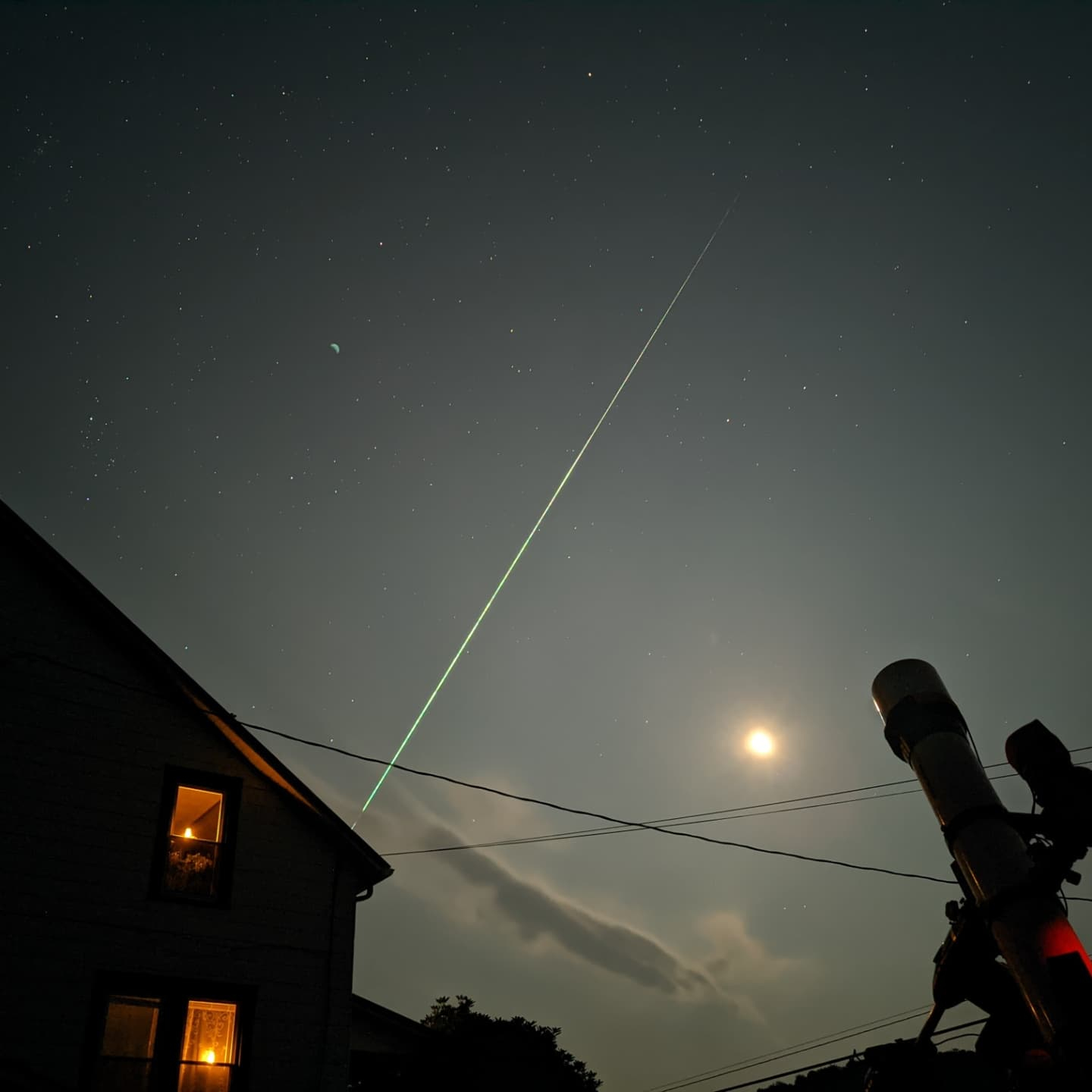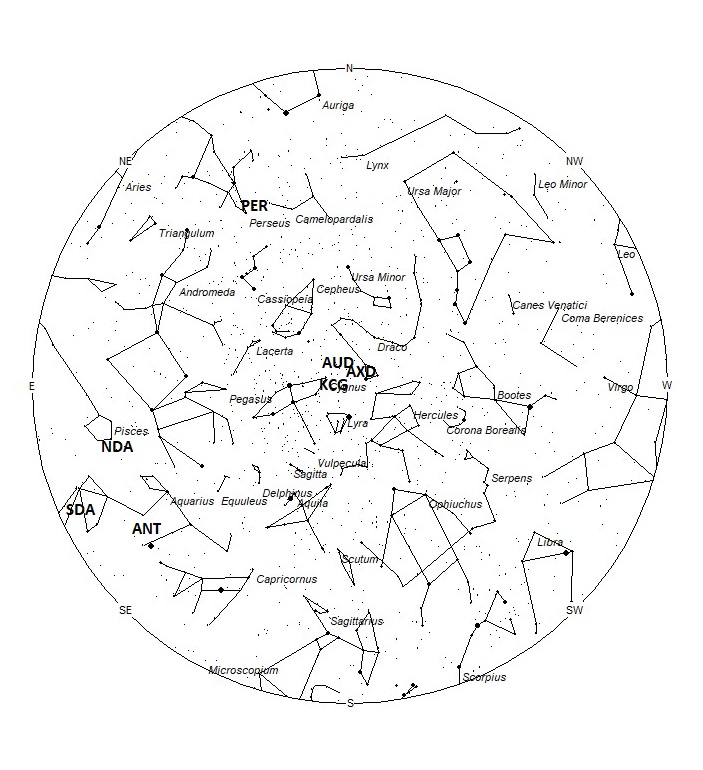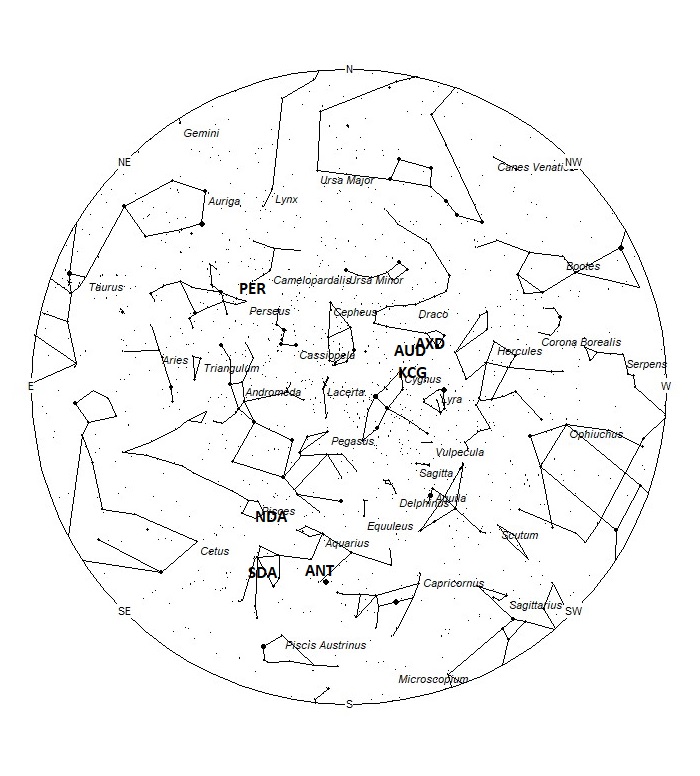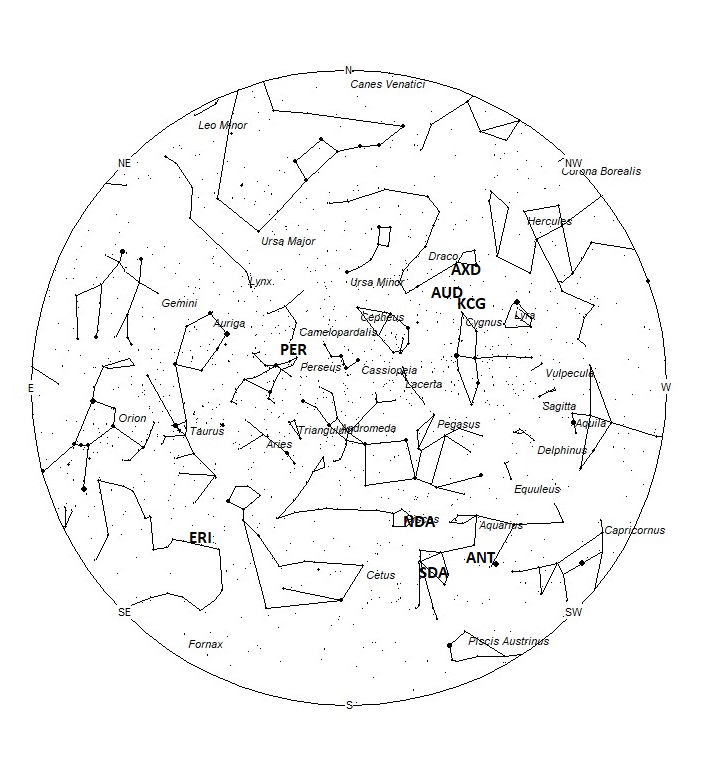 Wojciech Maziarz captured this fireball on the morning of 1 August 2021 at 2:35am EDT (6:51UT) from South Gibson, PA, USA. For more information on this fireball, visit: https://fireball.amsmeteors.org/members/imo_view/event/2021/4202 ©Wojciech Maziarz
Wojciech Maziarz captured this fireball on the morning of 1 August 2021 at 2:35am EDT (6:51UT) from South Gibson, PA, USA. For more information on this fireball, visit: https://fireball.amsmeteors.org/members/imo_view/event/2021/4202 ©Wojciech MaziarzDuring this period, the moon reaches its first quarter phase on Sunday August 15th. At that time the moon lies 90 degrees east of the sun and sets near 23:00 local daylight saving time (on Aug. 14). As the week progresses the waxing gibbous moon sets later and later, diminishing the available time of dark sky with each passing night. The estimated total hourly meteor rates for evening observers this week is near 4 as seen from mid-northern latitudes (45N) and 3 as seen from tropical southern locations (25S). For morning observers, the estimated total hourly rates should be near 27 as seen from mid-northern latitudes (45N) and 12 as seen from tropical southern locations (25S). The actual rates will also depend on factors such as personal light and motion perception, local weather conditions, alertness, and experience in watching meteor activity. Evening rates are reduced this week due to interfering moonlight. Note that the hourly rates listed below are estimates as viewed from dark sky sites away from urban light sources. Observers viewing from urban areas will see less activity as only the brighter meteors will be visible from such locations.
The radiant (the area of the sky where meteors appear to shoot from) positions and rates listed below are exact for Saturday night/Sunday morning August 14/15. These positions do not change greatly day to day so the listed coordinates may be used during this entire period. Most star atlases (available at science stores and planetariums) will provide maps with grid lines of the celestial coordinates so that you may find out exactly where these positions are located in the sky. I have also included charts of the sky that display the radiant positions for evening, midnight, and morning. The center of each chart is the sky directly overhead at the appropriate hour. These charts are oriented for facing south but can be used for any direction by rotating the charts to the desired direction. A planisphere or computer planetarium program is also useful in showing the sky at any time of night on any date of the year. Activity from each radiant is best seen when it is positioned highest in the sky, either due north or south along the meridian, depending on your latitude. It must be remembered that meteor activity is rarely seen at the radiant position. Rather they shoot outwards from the radiant, so it is best to center your field of view so that the radiant lies at the edge and not the center. Viewing there will allow you to easily trace the path of each meteor back to the radiant (if it is a shower member) or in another direction if it is sporadic. Meteor activity is not seen from radiants that are located far below the horizon. The positions below are listed in a west to east manner in order of right ascension (celestial longitude). The positions listed first are located further west therefore are accessible earlier in the night while those listed further down the list rise later in the night.
These sources of meteoric activity are expected to be active this week.
.
The August xi Draconids (AXD) was discovered by Masahiro Koseki in his study of SonotaCo Net video observations 2007–2018. These meteors were long considered part of the kappa Cygnids but Koseki states that they are clearly distinct*. This stream is active from August 4-28 with maximum activity occurring on the 14th. The radiant is currently located at 18:24 (276) +55, which places it in southern Draco, 5 degrees northeast of the 2nd magnitude star known as Eltanin (gamma Draconis). This radiant is best placed near 2200 local daylight saving time (LDST), when it lies on the meridian and is located highest in the sky. With an entry velocity of 21 km/sec., the average August xi Draconid meteor would be of slow velocity. Rates this week are expected to be less than 1 no matter your location. Due to the high northern declination these meteors are difficult to observe from the southern hemisphere.
*The activity of meteor showers recorded by SonotaCo Net video observations 2007–2018, Masahiro Koseki, 2021, https://www.meteornews.net/2021/02/09/february-2021-special-issue-of-emeteornews-online/ Page 147
The zeta Draconids (AUD) were discovered by Zdenek Sekanina in his study of meteor streams using radio methods. This stream is active from August 12-September 5 with maximum activity occurring on August 26. The radiant is currently located at 19:06 (287) +59, which places it in southeastern Draco, just a few degrees east of the faint star known as omicron Draconis. This radiant is best placed near 2300 LDST, when it lies on the meridian and is located highest in the sky. With an entry velocity of 21 km/sec., the average zeta Draconid meteor would be of slow velocity. Rates this week are expected to be less than 1 no matter your location. Due to the high northern declination these meteors are difficult to observe from the southern hemisphere. This position is close to that of the kappa Cygnid radiant so care should be taken to differentiate between these meteors. These meteors are synomous with the August Draconids (AUD).
The kappa Cygnids (KCG) are active from August 1-27, with maximum occurring on the 13th. The radiant shifts rapidly towards the northeast with each passing night. The radiant is currently located at 19:08 (287) +52, which places it in northwestern Cygnus, 2 degrees southwest of the 4th magnitude star known as kappa Cygni. This radiant is also best placed near 2300 LDST when it lies on the meridian and is located highest in the sky. With a high northern declination, these meteors are difficult to view from the southern hemisphere. Expected hourly rates this week are less than 1 no matter your location. With an entry velocity of 23 km/sec., the average meteor from this source would be of slow velocity.
The center of the large Anthelion (ANT) radiant is currently located at 22:20 (335) -10. This position lies in central Aquarius, 2 degrees southwest of the 4th magnitude star known as Ancha (theta Aquarii). This position is also 3 degrees northeast of the brilliant planet Jupiter. Due to the large size of this radiant, Anthelion activity may also appear from eastern Capricornus as well as Aquarius. This radiant is best placed near 0200 LDST, when it lies on the meridian and is located highest in the sky. Rates at this time should be near 2 per hour no matter your location. With an entry velocity of 30 km/sec., the average Anthelion meteor would be of slow velocity.
The Northern delta Aquariids are a conglomeration of at least two weak radiants that peak 10 days apart. These meteors were first mentioned by Luigi G. Jacchia in his book The Moon, Meteorites and Comets. The NDA’s are active from August 2-17, with peak rates occurring on the 11th. The radiant currently is located near 23:14 (349) +02. This area of the sky is located on the western Pisces, 1 degree southwest of the 4th magnitude star known as gamma Piscium. This radiant is best placed near 0300 LDST, when it lies on the meridian and is located highest in the sky. Hourly rates at this time should be less than 1 no matter your location. With an entry velocity of 39 km/sec., the average meteor from this source would be of medium velocity.
The August beta Piscids (NDA) are part of the Northern delta Aquariid complex, active from August 18-September 8. This second peak of the NDA’s occurs on August 21st, when the radiant lies well within the boundaries of the constellation of Pisces. On August 18, the radiant lies at 23:24 (351) +04, which is located within the “circlet” of Pisces, 2 degrees east of the 4th magnitude star known as gamma Piscium. This radiant is best placed near 0300 LDST, when it lies on the meridian and is located highest in the sky. Hourly rates at this time should be less than 1 no matter your location. With an entry velocity of 38 km/sec., the average meteor from this source would be of medium velocity.
The Southern delta Aquariids (SDA) are active from a radiant located at 23:24 (351) -14. This area of the sky is located in central Aquarius, 6 degrees northeast of the 3rd magnitude star known as Skat (delta Aquarii). This radiant is best placed near 0300 LDST, when it lies on the meridian and is located highest in the sky. Hourly rates at this time should be less than 1 as seen from the Northern Hemisphere and near 1 as seen from south of the equator, where the radiant lies higher in the sky. With an entry velocity of 38 km/sec., the average meteor from this source would be of medium velocity.
The August gamma Cepheids (AGC) are a recent discovery by Damir Šegon and the Croatian Meteor Network team based on studying SonotaCo and CMN observations (SonotaCo 2007-2011, CMN 2007-2010). Meteors from this source are expected from August 17 through September 6, with maximum activity occurring on August 29. The current position lies at 23:42 (356) +73, which lies in eastern Cepheus, 5 degrees south of the 3rd magnitude star known as Errai (gamma Cephei A). This radiant is best placed near 0300 LDST, when it lies on the meridian and is located highest in the sky. Rates at this time should be less than 1 per hour as no matter your location. With an entry velocity of 42 km/sec., the average meteor would be of medium velocity. These meteors are not visible south of latitude 20 South.
There is a slight possibility of activity from the beta Hydrusids (BHY) near 20:26 UT on August 16th. This timing favors southern Africa and the southern Indian Ocean area. The far southern radiant is located at 02:25 (036) -75. This position lies just southwest of the small Magellanic Cloud or 5 degrees northwest of the 3rd magnitude star known as beta Hydri. This position is best placed during the last dark hour prior to dawn when the radiant lies highest above the horizon in a dark sky. The visibility of these meteors are pretty much limited to the southern hemisphere as the radiant only lies 15 degrees from the southern celestial pole. With an entry velocity of 23km/sec., most activity from this radiant would be of slow velocities.
The eta Eridanids (ERI) are active from a radiant near 03:15 (049) -10. This position lies in northern Eridanus, 1 degree north of the faint star known as zeta Eridani. This source is active until September 10th, with maximum activity occurring on August 6th. Current rates would be near 1 per hour no matter your location. These meteors are best seen during the last dark hour prior to dawn when the radiant lies highest above the horizon in a dark sky. With an entry velocity of 64 km/sec., the average meteor from this source would be of swift speed.
The Perseids (PER) are still active from a radiant located at 03:30 (053) +59. This position lies in southwestern Camelopardalis, 10 degrees north of the 2nd magnitude star known as Mirfak (alpha Persei). This area of the sky is best placed for viewing during the last dark hour before dawn when it lies highest in the sky. Current hourly rates are expected to be near 10 as seen from the Northern Hemisphere and near 1 as seen from south of the equator. These rates will decrease with each passing night as the week progresses. With an entry velocity of 59 km/sec., the average meteor from this source would be of swift velocity.
As seen from the mid-northern hemisphere (45N) one would expect to see approximately 14 sporadic meteors per hour during the last hour before dawn as seen from rural observing sites. Evening rates would be near 4 per hour. As seen from the tropical southern latitudes (25S), morning rates would be near 9 per hour as seen from rural observing sites and 3 per hour during the evening hours. Locations between these two extremes would see activity between the listed figures.
|
SHOWER |
DATE OF MAXIMUM ACTIVITY | CELESTIAL POSITION | ENTRY VELOCITY | CULMINATION | HOURLY RATE | CLASS |
| RA (RA in Deg.) DEC | Km/Sec | Local Daylight Saving Time | North-South | |||
| August xi Draconids (AXD) | Aug 14 | 18:24 (276) +55 | 21 | 22:00 | <1 – <1 | IV |
| zeta Draconids (AUD) | Aug 26 | 19:06 (287) +59 | 21 | 23:00 | <1 – <1 | IV |
| kappa Cygnids (KCG) | Aug 13 | 19:08 (287) +52 | 23 | 23:00 | <1 – <1 | IV |
| Anthelion (ANT) | – | 22:20 (335) -10 | 30 | 02:00 | 2 – 2 | II |
| Northern delta Aquariids (NDA) | Aug 11 | 23:14 (349) +02 | 38 | 03:00 | <1 – <1 | IV |
| August beta Piscids (NDA) | Aug 21 | 23:24 (351) +04 | 38 | 03:00 | <1 – <1 | IV |
| Southern delta Aquariids (SDA) | Jul 30 | 23:24 (351) -14 | 39 | 03:00 | <1 – 1 | I |
| August gamma Cepheids (AGC) | Aug 29 | 23:42 (356) +73 | 42 | 03:00 | <1 – <1 | IV |
| beta Hydrusids (BHY) | Aug 16 | 02:25 (036) -75 | 23 | 06:00 | <1 – <1 | III |
| eta Eridanids (ERI) | Aug 06 | 03:15 (049) -10 | 64 | 07:00 | 1 – 1 | IV |
| Perseids (PER) | Aug 13 | 03:30 (053) +59 | 59 | 07:00 | 10 – 1 | I |
 American Meteor Society
American Meteor Society



Hello Hello, how y’all doing? I’m Nathan Strowmatt, I live in Bryan, TX., and i just a kick ass looking meteor streaking out of completely nowhere. Like in the middle of your television set it appeared and was well below what appeared to be just a couple thousand yards in elevation. Rapidly changing colors, the likes of which are not even describable.
I live in north western PA near pymatuning state park. I was outside on 8/14/2021 looking in a generally western direction when at around 10 pm, could have been a little later, I saw a “shooting star” that was brighter than any one I have ever seen before. Then, the thing turned a bright green and burnt out. It was one of the coolest things I have ever seen. I’m assuming that it must have contained a bit of copper in it, but I am no scientist.